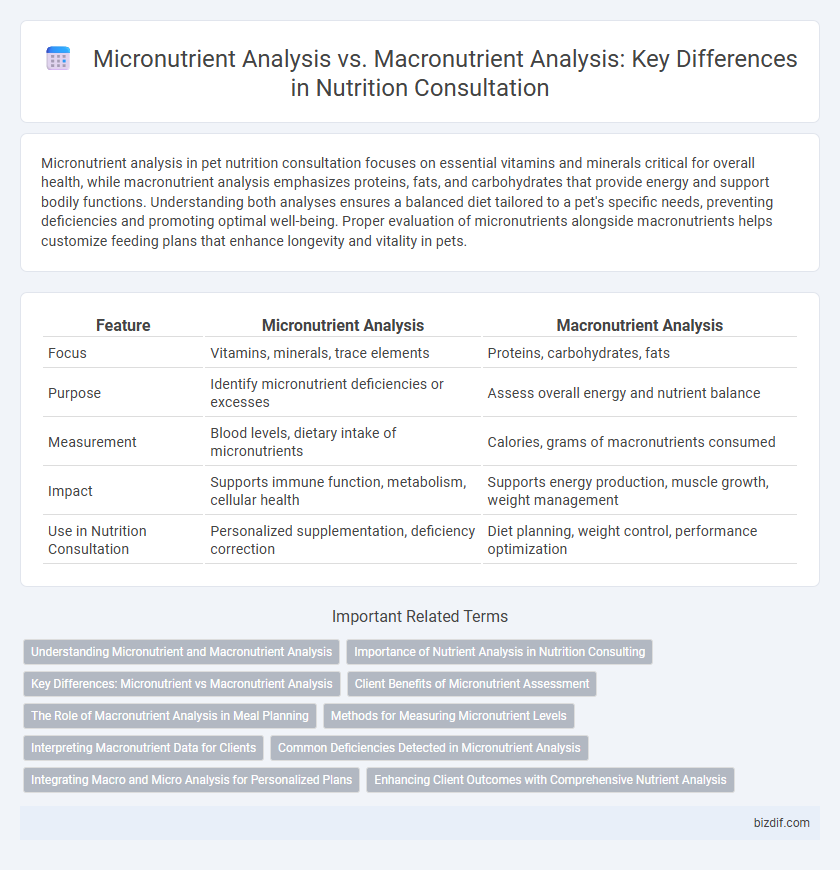Micronutrient analysis in pet nutrition consultation focuses on essential vitamins and minerals critical for overall health, while macronutrient analysis emphasizes proteins, fats, and carbohydrates that provide energy and support bodily functions. Understanding both analyses ensures a balanced diet tailored to a pet's specific needs, preventing deficiencies and promoting optimal well-being. Proper evaluation of micronutrients alongside macronutrients helps customize feeding plans that enhance longevity and vitality in pets.
Table of Comparison
| Feature | Micronutrient Analysis | Macronutrient Analysis |
|---|---|---|
| Focus | Vitamins, minerals, trace elements | Proteins, carbohydrates, fats |
| Purpose | Identify micronutrient deficiencies or excesses | Assess overall energy and nutrient balance |
| Measurement | Blood levels, dietary intake of micronutrients | Calories, grams of macronutrients consumed |
| Impact | Supports immune function, metabolism, cellular health | Supports energy production, muscle growth, weight management |
| Use in Nutrition Consultation | Personalized supplementation, deficiency correction | Diet planning, weight control, performance optimization |
Understanding Micronutrient and Macronutrient Analysis
Micronutrient analysis evaluates essential vitamins and minerals like iron, vitamin D, and zinc, crucial for metabolic functions and immune support, while macronutrient analysis measures carbohydrates, proteins, and fats that provide the body's primary energy sources. Understanding micronutrient status helps identify deficiencies or toxicities that can impact overall health, whereas macronutrient balance is fundamental for weight management, energy regulation, and muscle maintenance. Effective nutrition consultation integrates both analyses to tailor dietary recommendations that optimize individual health outcomes and prevent chronic diseases.
Importance of Nutrient Analysis in Nutrition Consulting
Micronutrient analysis evaluates vitamins and minerals essential for cellular function, immune support, and metabolic processes, while macronutrient analysis measures carbohydrates, proteins, and fats critical for energy and body composition. Accurate nutrient analysis in nutrition consulting identifies specific deficiencies or excesses, enabling personalized dietary plans to improve health outcomes and prevent chronic diseases. Understanding both micro and macronutrient status ensures a comprehensive approach to optimizing nutrient intake and overall wellness.
Key Differences: Micronutrient vs Macronutrient Analysis
Micronutrient analysis evaluates vitamins and minerals essential for cellular functions, immune support, and metabolic processes, while macronutrient analysis measures carbohydrates, proteins, and fats that provide energy and structural components. Micronutrient analysis focuses on trace element deficiencies and toxicities, critical for preventing chronic diseases, whereas macronutrient analysis assesses calorie intake and nutrient balance for weight and muscle management. Both analyses inform personalized nutrition plans, but micronutrient evaluation targets biochemical balance, and macronutrient assessment emphasizes energy distribution.
Client Benefits of Micronutrient Assessment
Micronutrient assessment provides clients with detailed insights into vitamin and mineral levels that are essential for optimal metabolic function and immune health. Unlike macronutrient analysis, which focuses on calories and macronutrient ratios, micronutrient testing uncovers specific nutrient deficiencies that can impact energy, cognitive function, and chronic disease risk. Tailoring nutrition plans based on micronutrient data enhances personalized dietary interventions and supports long-term wellness outcomes.
The Role of Macronutrient Analysis in Meal Planning
Macronutrient analysis plays a crucial role in meal planning by quantifying the intake of proteins, carbohydrates, and fats to align with individual health goals and energy requirements. Precise tracking of macronutrients enables customization of meals for weight management, muscle gain, or metabolic health improvement. This focus ensures balanced nutrition and supports optimal bodily functions and overall wellness.
Methods for Measuring Micronutrient Levels
Micronutrient analysis primarily involves advanced biochemical assays such as atomic absorption spectroscopy, high-performance liquid chromatography, and enzyme-linked immunosorbent assays to accurately quantify vitamins and trace minerals at cellular levels. In comparison, macronutrient analysis often uses indirect calorimetry and dietary recall methods focusing on carbohydrates, proteins, and fats intake without precise micronutrient detail. Accurate micronutrient measurement is critical for diagnosing deficiencies and tailoring personalized nutrition plans.
Interpreting Macronutrient Data for Clients
Interpreting macronutrient data involves analyzing the intake of proteins, carbohydrates, and fats to optimize clients' dietary balance and support their health goals. Accurate macronutrient assessment helps tailor nutrition plans by identifying excesses or deficiencies that impact energy levels, metabolic function, and weight management. Understanding the role of each macronutrient enhances personalized strategies for improving overall nutritional status and achieving client-specific outcomes.
Common Deficiencies Detected in Micronutrient Analysis
Micronutrient analysis identifies common deficiencies in vitamins and minerals such as vitamin D, iron, magnesium, and zinc, which can impact energy production, immune function, and bone health. Macronutrient analysis primarily evaluates the intake of carbohydrates, proteins, and fats, focusing on total calorie balance and macronutrient distribution rather than specific nutrient deficits. Detecting micronutrient deficiencies is crucial for tailored nutrition consultation, enabling targeted supplementation and dietary adjustments to optimize metabolic functions and overall well-being.
Integrating Macro and Micro Analysis for Personalized Plans
Integrating micronutrient analysis with macronutrient profiling enables personalized nutrition plans that address both energy needs and essential vitamin and mineral imbalances. This comprehensive approach enhances nutrient bioavailability and supports metabolic pathways critical for individual health goals. Tailored interventions based on combined macro and micro data optimize dietary strategies for improved outcomes in weight management, disease prevention, and vitality.
Enhancing Client Outcomes with Comprehensive Nutrient Analysis
Comprehensive nutrient analysis integrates micronutrient and macronutrient assessments to optimize client outcomes by identifying specific vitamin, mineral, protein, carbohydrate, and fat imbalances. Micronutrient analysis detects deficiencies or excesses in essential vitamins and minerals critical for metabolic functions, while macronutrient analysis focuses on caloric distribution and energy balance. Combining both analyses enables personalized nutrition plans that improve metabolism, immunity, and overall health.
Micronutrient analysis vs macronutrient analysis Infographic

 bizdif.com
bizdif.com